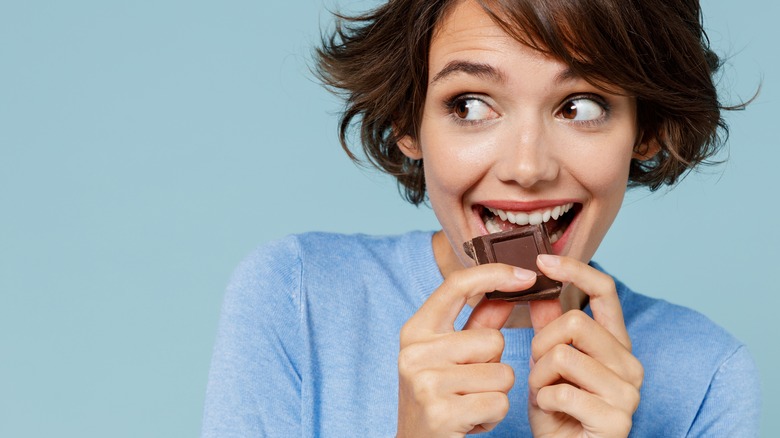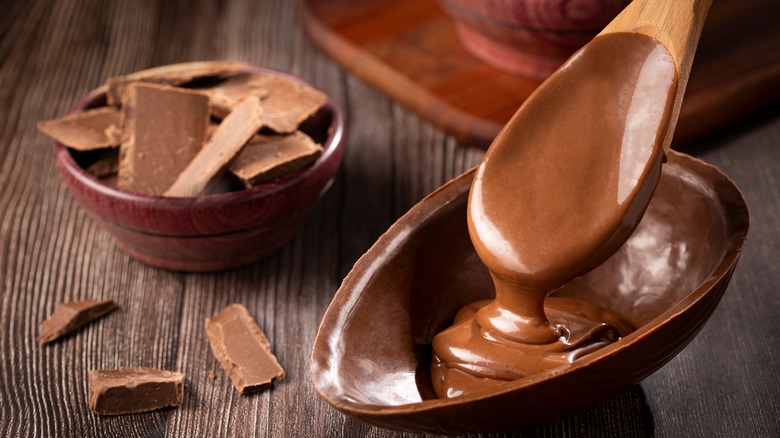The Scientific Reason People Love Chocolate
It's impossible to overstate how much people love chocolate and the lengths they will go to in order to validate that love. Every new year seems to bring a fresh batch of studies indicating that dark chocolate is good for your health. At this point, we're thinking of it less like candy and more like a superfood. If that sounds too good to be true, it's because it probably is. Vox reveals that these research efforts are usually funded by big chocolate brands. Some of the world's foremost producers, like Hershey's, Mars, and Nestlé, have poured millions of dollars into cocoa science, and the fact that nearly 100% of studies return glowing results is more than a little suspicious.
The science isn't exactly wrong, just misleading. In 2022, The New York Times interviewed Dr. Dariush Mozaffarian, a cardiologist and professor of nutrition at Tufts University, who explained that cocoa beans have legitimate nutritional value. They're packed with fiber, phytonutrients, and flavonols. But just because cocoa is good for you doesn't mean chocolate is. Science of Cooking points out that chocolate makers add a good deal of sugar to balance the natural bitterness of cocoa. They also add cocoa butter, which is pure fat extracted from the bean, added in excess to make the chocolate smooth. If only we could make great chocolate without the consequences of sugar and fat. Actually, we might, thanks to a study that gets to the root of why we love chocolate so much.
The texture is key
Mouthfeel is an important aspect of all foods, but this is doubly true when we're talking about chocolate. Its melt-in-your-mouth creaminess is a huge part of its appeal. A team at the University of Leeds set out to determine why chocolate has such a unique mouthfeel, using an artificial human tongue. They discovered that the fat in chocolate mingles with saliva to create a thin film over all our oral surfaces. This film makes chocolate feel ultra smooth from the first bite to the last. According to the BBC, this texture stimulates touch receptors on our tongues that trigger feelings of pleasure.
You might be wondering what the point of all this is. Think back to what we said about the fat content of chocolate, which comes from added cocoa butter. According to Science of Cooking, this is done to give the chocolate a smooth texture. The team at Leeds discovered that our perception of chocolate's texture is really determined by the fatty film that forms as soon as we take our first bite. Once the film has formed, the remaining cocoa butter serves no purpose. Therefore, the researchers think we can make tasty chocolate with much less fat. As long as there is a small amount of fat on the chocolate's surface, we should experience the same fatty film effect as we would with higher-fat versions. Could this be the key to making chocolate legitimately healthy?
The Leeds research doesn't tell the whole story
The University of Leeds provides a fascinating launch point for further research, but their study leaves some big questions unanswered. The researchers suggest that we can make chocolate with less fat, as long as that fat is concentrated on the surface to form a fatty film in our mouths, but they don't provide specific details as to how this new style of chocolate could be made. They also don't address the purpose of fat beyond mouthfeel. According to Britannica, cocoa butter is necessary to make chocolate hold its shape. Without the addition of cocoa butter, solid chocolate wouldn't be possible, and we certainly couldn't mold it into Hershey's Kisses. There's a limit to how much fat we can remove from the equation.
It's also important to note that texture is far from the only reason we love chocolate, and fat is not the only unhealthy part of it. Obviously, sugar plays a huge role as well. There's a particular ratio of sugar to fat that we seem to find particularly appealing, and there's an incredible theory as to why. The BBC explains that sugar and fat are rarely found together in nature. The notable exception is in milk. Human breast milk has a ratio of one part fat to two parts sugar, and this is the same ratio that's used in milk chocolate. Our craving for chocolate goes beyond its texture. It's taking us back to the first food we ever consumed.


